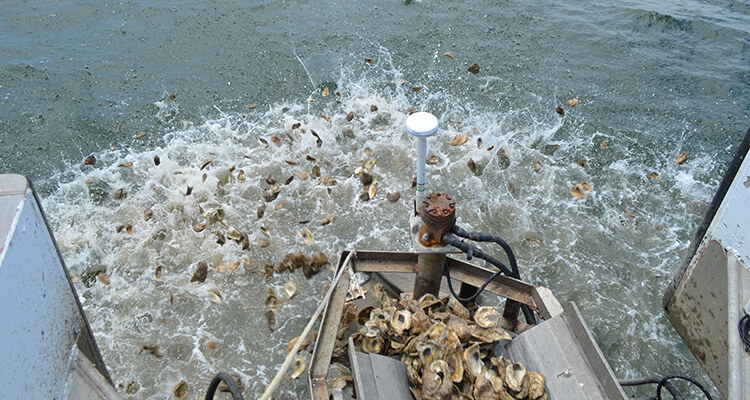
On Monday, a coalition of Chesapeake Bay advocates launched a lofty new commitment: adding 10 billion new oysters to the Chesapeake Bay by 2025.
Local oyster populations are currently said to be less than 1 percent of their historic peak, which some estimate included as many as one trillion oysters only 150 years ago. Numbers started to plummet in the late 1800s, with current estimates as low as one billion, due in part to overharvesting, habitat loss, pollution, and disease.
In a Herculean effort, the Chesapeake 10 Billion Oysters Partnership—made up of some 20 nonprofits, scientific organizations, community groups, and oystermen from Maryland and Virginia—wants to bring the oyster back, and, in doing so, the health of the Chesapeake Bay.
“As a bay community, we have come a long way—oysters are doing much better, but they’re nowhere near where they could be,” says Will Baker, president of the Chesapeake Bay Foundation (CBF). “We hope that setting a numeric goal can have a real effect on accelerating that restoration.”
Over the course of the next seven years, this collaborative initiative has three priorities: restore oyster sanctuaries, or traditional oyster reefs restricted from harvest; promote science-based fishery management, as more than 75 percent of the bay’s oyster bottom is open to commercial fishing; and increase oyster aquaculture, a fast-growing industry that involves cultivating seafood in an aquatic environment.
The end-goals start with water quality. In recent years, the Chesapeake Bay has shown signs of improved health, including increased water clarity and the resurgence of underwater grasses, but it still earns a C on its annual environmental report card. One mature oyster can filter as much as 50 gallons of water each day, with local lore claiming that the historic bivalves were once able to filter the entire 18-trillion-gallon estuary in as little as one week. Ten billion oysters could eventually mean as much as 500 billion gallons every 24 hours.
Oyster restoration is nothing new for the Chesapeake Bay, where efforts have been in place for decades and some 1 billion spat, or baby oysters, are now planted each year. Currently, the Chesapeake Bay Watershed Agreement has been working since 2014 to restore and protect oyster sanctuaries in 10 regional tributaries by the same deadline of 2025. In Baltimore, the CBF and Waterfront Partnership’s Great Baltimore Oyster Partnership are growing an annual 250,000 oysters in five oyster gardens around the harbor that are then transferred to an oyster sanctuary on the Patapsco River.
In addition to water quality, oyster reefs act as habitat for small fish, invertebrates, as well as their own young. Oyster larvae latch onto these hardy, intricate structures, often made up of the shells of adult oysters, where they can then safely grow. Through organizations like the Oyster Recovery Partnership (ORP), oyster shells are now being regularly recycled throughout the region to help rebuild depleted reefs, with each bushel of shell able to produce some 6,000 baby oysters. One such location is at the National Aquarium, where an artificial reef sits near Pier 3.
Reefs also help protect shorelines, acting as a buffer from inclement or, these days, extreme weather. After Hurricane Sandy, the state of New York approved a $60-million restoration project to add oyster beds back into the New York City harbor, where some 200,000 acres of reef once protected against erosion, storm damage, and flooding. The city’s similar Billion Oyster Project also has the goal of adding one billion oysters to the waters by 2035. “Oysters are increasingly being seen as a relatively inexpensive way to gird the environment against natural catastrophes which we know are coming with climate change,” says Rona Kobell, science writer for the Maryland Sea Grant and former reporter for the Chesapeake Bay Journal where she covered the oyster industry. “You can also use volunteers and make it an educational tool.”
Beyond environmental impacts, another goal of the 10 Billion Oysters Partnership is to engage new constituencies and inspire government action in uncertain political times. “We realistically believe this is an attainable goal,” says Baker, noting that a formal population study won’t be complete until the end of the year, “but there’s one wild card, and that’s federal funding.”
The Trump Administration has proposed budget cuts that would dramatically impact restoration efforts on the Chesapeake Bay, including eliminating the Environmental Protection Agency’s funding for cleanup efforts via the Chesapeake Bay Program, as well as support for other critical programs led by the Army Corps of Engineers and the National Oceanic and Atmospheric Administration (NOAA), like the Sea Grant. “One of the big parts of this partnership will be lobbying for federal and state money,” says Baker. “We’re very concerned that those resources will not be available without a real fight.”
The coalition also hopes to drive economic growth throughout the watershed. Maryland and Virginia have lost more than $4 billion in the last three decades due to oyster population decline. “More oysters are going to mean more jobs,” says Baker. “Jobs occur at every level of the species. The wild harvest clearly involves commercial watermen who for centuries have caught oysters along the Chesapeake Bay. Those are really important jobs, especially for local, rural communities. But that only tells part of the story. Once an oyster hits the dock, it takes many people to process, ship, and prepare it, so there are economic multipliers that people don’t often think of.”
The same notion applies to oyster aquaculture, commonly referred to as oyster farming, which raises native Eastern, or crassotrea virginica, oysters around the bay. As the wild harvest continues to struggle, oyster farming has grown into a $30-million industry. Virginia leads the charge, having adopted the practice as far back as the 19th century. Maryland, on the other hand, took until 2009 to fully support it across the state, but since 2012, the number of aquaculture leases has jumped by 1,000 percent.
As the owner of the Orchard Point Oyster Company on the Eastern Shore, Scott Budden sees the coalition’s large network as a major advantage for both new and established oyster farmers. “For new growers, the coalition provides a big resource,” he says, as starting an oyster farm requires not only financial capital but also technical know-how and state approval. “For those of us who have been around a little while, it gives us political clout. There’s currently no unified shellfish growers’ association in Maryland, so we don’t have a political arm to lean on when things come through Annapolis that are potentially detrimental to our industry.”
With previously individual efforts uniting for this common goal, it’s a matter of strength in numbers, with each of the 20 partners able to benefit from the other, be it a local university, NGO, or federal agency—a recreational oyster gardener, professional oyster farmer, or traditional waterman. There has long been a contentious, somewhat territorial relationship between the latter two, but programs like OysterFutures, run by the University of Maryland Center for Environmental Science (UMCES) and the likes of waterman-turned-aquaculturist Johnny Shockley of Hoopers Island Oyster Company, have been working to bring those communities together and encourage both to succeed.
“The goal here is to build oyster populations, increase their ecological role in the sanctuaries, and really promote and develop aquaculture into its full potential,” says Donald Boesch, president emeritus of UMCES and one of the partnership’s scientific advisors, “but also to use good science to find more sustainable ways to allow a public fishery.”
But the question remains: Is this ambitious objective even realistic? “What makes this partnership unique is the audacity of the number,” says John Racanelli, CEO of the National Aquarium. “Growing our oyster population tenfold by 2025 is a bold, yet attainable goal.”
Boesch points to the UMCES-run Horn Point Laboratory oyster hatchery on the Eastern Shore, where nearly 2 billion spat-on-shell are now produced each year. “My colleagues and I looked at this and said, ‘Why limit it to 10 billion?’”
And if they hit that mark before their deadline? “You can rest assured,” says Baker, “we’re going to set a higher goal and keep on working.”
